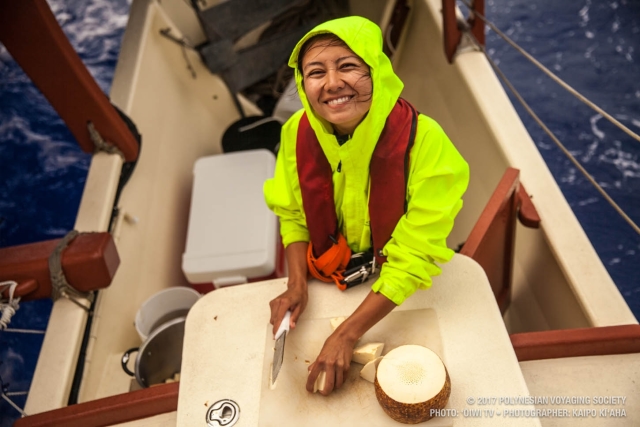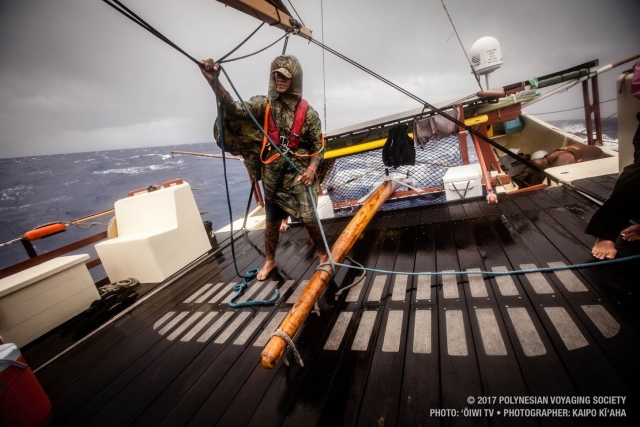
Hikianalia Update | March 27, 2017
- Posted on 28 Mar 2017
- In Hikianalia Updates, Newsletter, Photo Galleries, Teachers, Updates
 Blog by Kaipo Kiaha
Blog by Kaipo Kiaha
As is ritual on any deep sea voyage, our crew put away our wrist watches in order to rely on the elements to determine the time of day (even the computer I write this on has had its time set to a random hour, and the clock in the menu bar is hidden).
While on land, we are bound to the human construct of time. It tells us when to wake up, if we are late or early, and whether to feel nervous or impatient because of those things. When in reality, time is a made up idea based on the movement of the sun, moon, planets and stars. So by giving up this notion of time, we are surrendering to the primordial reign of the deep sea and the surrounding celestial bodies. We are living on waʻa time.
Waʻa time means you get up when you are on watch, and you go to sleep when you are off watch. It is roughly broken up in three: 6-10, 10-2, 2-6. However, these times are estimated. So really, if your watch is 2-6, you might actually be up from 1:30-6, or 2-6:30, or any other similar variation. While on land in our daily lives, being 15 or 30 minutes late to something might be a big deal. But on waʻa time, it doesn’t matter. And that is where the magic lies.
By giving up something as simple and ever present in our daily lives as a clock, we are able to focus that much more on the voyage itself. We get up not to be “on time,” but to relieve the crew before us who worked hard for 4 hours, because we care about them. We take the time to pray before meals, to serve food to our fellow crew members, and then wash their dishes. We take the time to check in on each other, and to make sure everyone is feeling okay. But perhaps most of all, we take the time to find joy in, and fully appreciate this amazing opportunity we all get to be a part of.
And now for some sailor-speak:
We have continued on our course of Manu/Nālani Malanai, averaging between 7 and 8 knots over the past 24 hours. We have estimated two positions (plotted on our navigation chart station), and covered almost 170 nautical miles. We’ve had a decent amount of cloud cover last night and throughout today, sometimes having complete cloud cover and other times around 50%. We ran into a few squalls last night and mid-morning today, but Hikianalia sailed through them swiftly.
The hoe ʻuli is still tied down, as our current sail set (main, mizzen, #16 and #7 jibs) and weight distribution is allowing Hikianalia to correct herself and hold the course line, rolling through the 8-10 foot swells out of Hikina and 20 knot wind out of Lā Koʻolau.
We saw a pod of pilot whales around 1pm this afternoon and some of them got close to the canoe but stayed underwater. Unfortunately I was too slow on the camera shutter to catch any good shots.
Our navigation team is using a dead reckoning system to check heading and speed, and coming up with a consensus on the average and estimating a position from there. However, since we have Hōkūpaʻa, we will use that to determine a more accurate latitudinal position at night.
We are expecting this wind to hold up until we get to the ITCZ, around 9 degrees north. We estimate we are just below 18 degrees at the moment, and we are trying to gain easting and maintain a fast speed in order to counteract the prevailing westerly current leading us leeward.
That being said, this first day at sea should give us an idea of what to expect over the next few days until we hit the ITCZ. All I can say is, it’s been great so far, and we are looking forward to the rest of our journey.
Hōkūle‘a Homecoming – Save the Date
We’ve got more details for you regarding Hōkūleʻa’s historic homecoming in June 2017! Click below to find out more:













